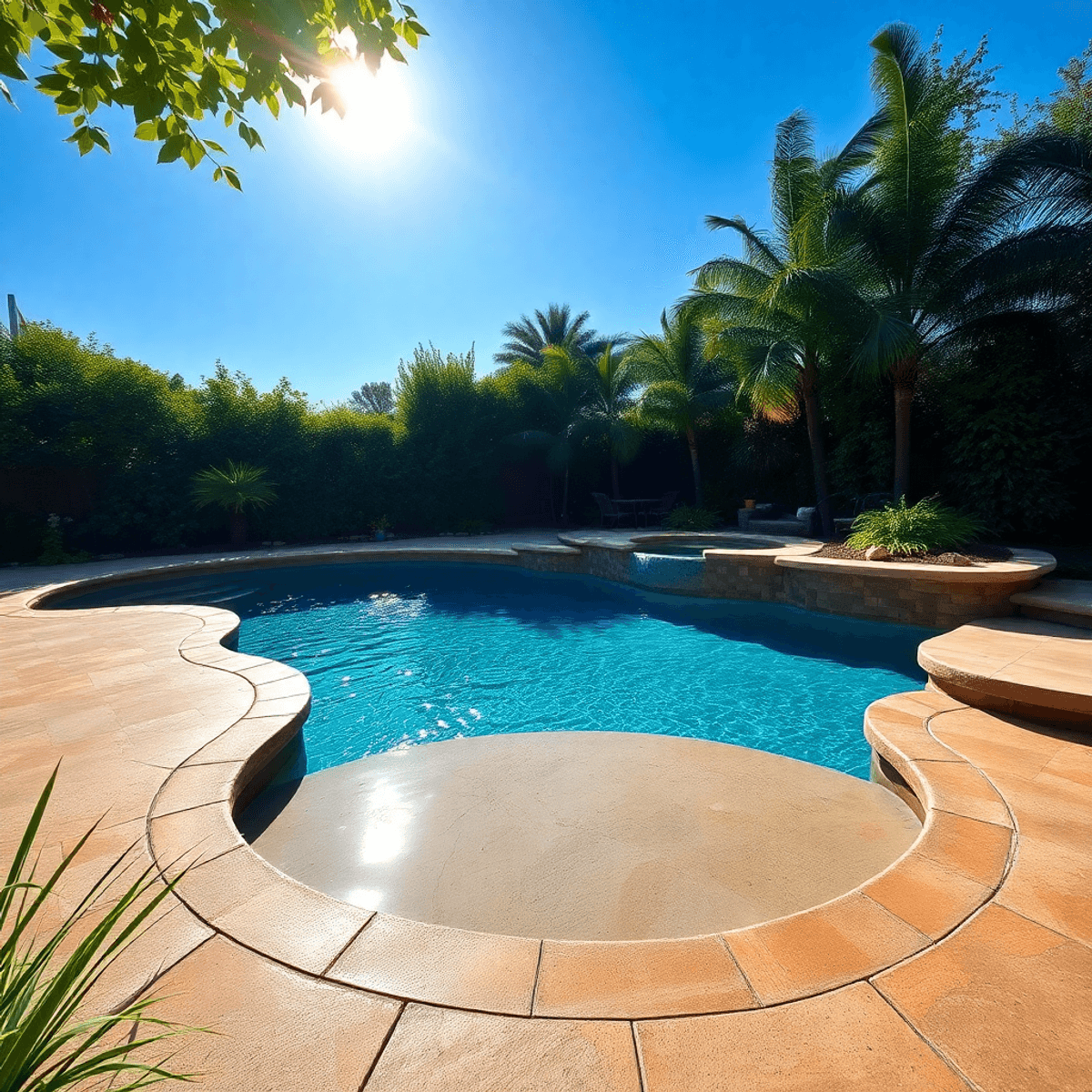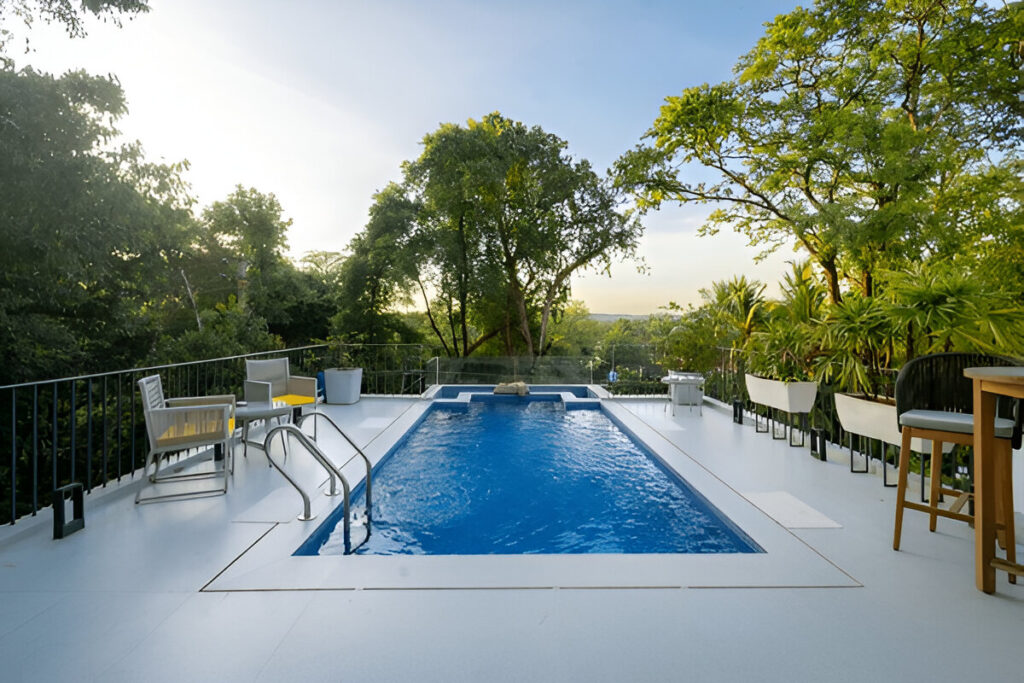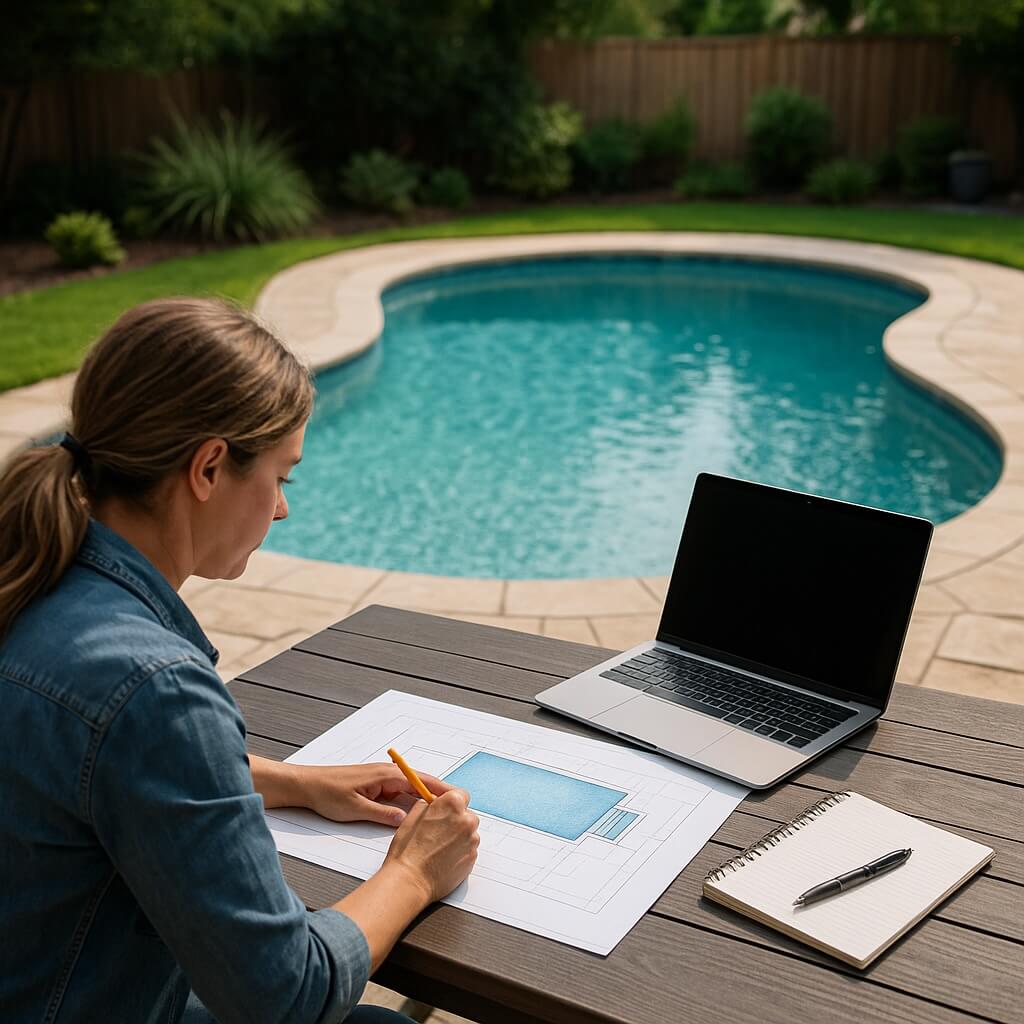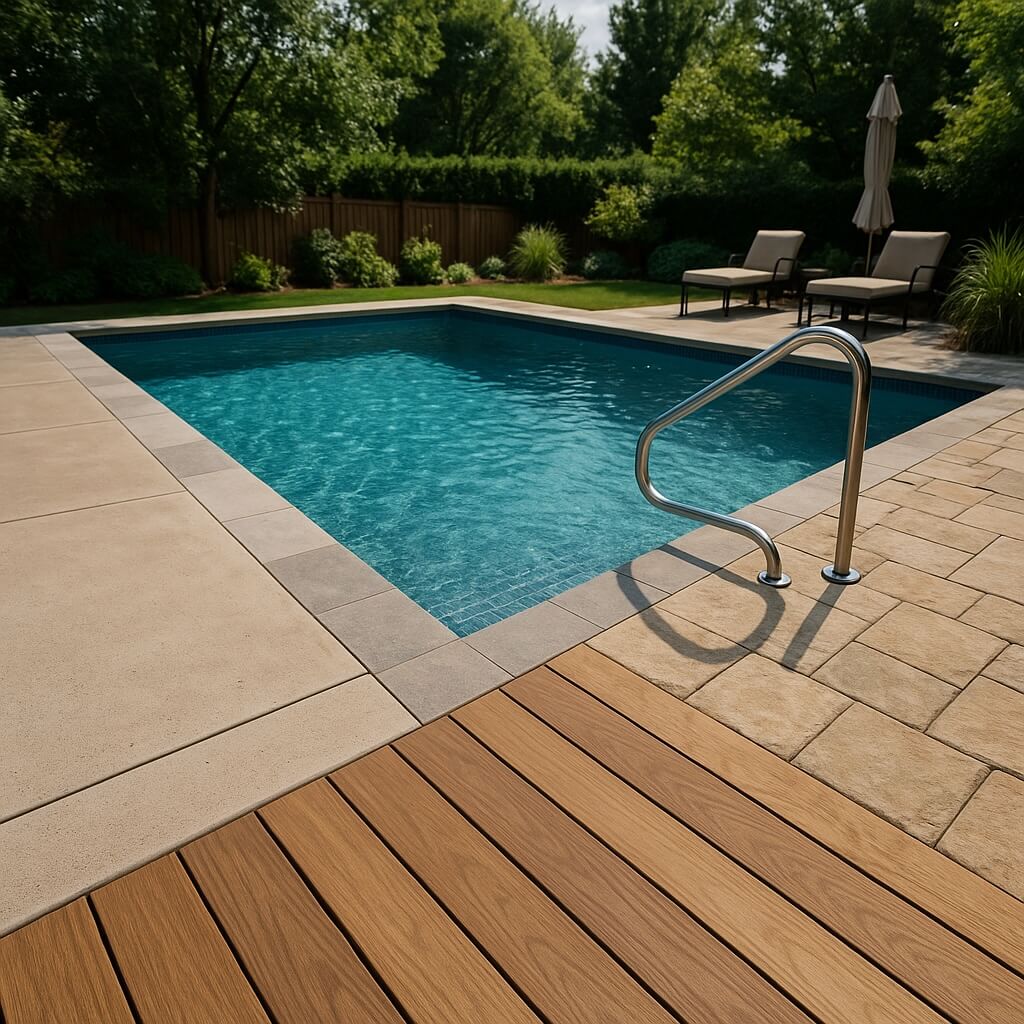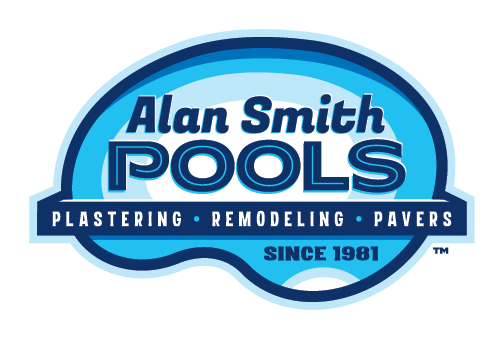Building a pool transforms your backyard into a personal oasis, but selecting the right type can feel overwhelming. Your choice between concrete, fiberglass, and vinyl pools will impact your swimming experience for years to come.
Think of pool selection as choosing a long-term investment in your property and lifestyle. Each pool type brings distinct advantages:
-
Concrete pools offer unlimited customization
-
Fiberglass pools excel in low maintenance
-
Vinyl liner pools provide cost-effective solutions
The right choice depends on various factors unique to your situation:
-
Your budget constraints
-
Available installation time
-
Desired customization options
-
Long-term maintenance preferences
-
Climate considerations
This guide walks you through the essential aspects of each pool type. You’ll discover the pros and cons, cost implications, and installation requirements. Armed with this knowledge, you can make an informed decision that aligns with your vision of the perfect backyard pool.
Understanding Concrete Pools (Gunite)
Concrete pools, also known as gunite pools, represent the pinnacle of custom pool design. These pools are built by spraying a mixture of concrete and sand onto a steel framework, creating a robust and highly customizable structure.
Design Flexibility
-
Unlimited shape possibilities – from classic rectangles to free-form designs
-
Custom depths to accommodate diving boards or shallow lounging areas
-
Integration of unique features like beach entries, swim-up bars, or infinity edges
-
Ability to incorporate intricate tile work and decorative elements
Construction Process
-
Steel rebar framework installation
-
Pneumatic application of gunite mixture
-
Plastering and finishing work
-
Installation of plumbing and electrical systems
Durability and Strength
Concrete pools boast exceptional structural integrity, lasting 50+ years with proper maintenance. The thick concrete shell withstands ground movement and pressure, making these pools suitable for all soil types.
Maintenance Requirements
-
Weekly chemical balance checks
-
Regular brushing to prevent algae growth
-
Acid washing every 3-5 years
-
Replastering needed every 10-15 years
-
Higher chemical usage due to porous surface
Advantages
-
Complete creative control over design
-
Superior strength and longevity
-
Ability to renovate and update over time
-
Highest property value addition
Challenges
-
Longer construction timeline (3-6 months)
-
Higher initial investment
-
Rough surface can cause swimsuit wear
-
Increased chemical and maintenance costs
-
Higher heating costs due to porous nature
The extensive customization options of concrete pools allow you to create your dream backyard oasis, though this flexibility comes with specific maintenance responsibilities and cost considerations.
Exploring Fiberglass Pools
Fiberglass pools are a modern solution in pool construction. They are made from a single-piece mold reinforced with multiple layers of fiberglass material. These pre-manufactured shells come ready for installation, making pool ownership easier.
Key Features of Fiberglass Pools:
-
Non-porous gelcoat surface that resists algae growth
-
Built-in steps, benches, and swim-outs
-
Smooth surface texture that’s gentle on feet and swimsuits
-
Compatible with saltwater systems
-
Available in various pre-designed shapes and sizes
The installation process for fiberglass pools is known for its efficiency. You can expect your pool to be ready for swimming in just 2-3 weeks, which is a significant advantage compared to the lengthy construction timeline of concrete pools.
Maintenance Requirements:
-
Weekly chemical balance checks
-
Regular brushing of pool walls
-
Minimal resurfacing needs
-
Standard filter system cleaning
The durability of fiberglass pools means substantial long-term savings. The gelcoat surface stays intact for decades without needing resurfacing, while the flexible nature of fiberglass allows these pools to adjust to ground movement without cracking.
Cost Considerations:
-
Initial investment: $30,000-$45,000
-
Lower chemical usage due to non-porous surface
-
Reduced electricity costs from efficient operation
-
Minimal long-term maintenance expenses
However, there are some limitations to consider:
Limitations:
-
Size restrictions due to shipping constraints
-
Limited customization options
-
Depth typically maxes out at 8 feet
-
Pre-determined shapes and designs
The combination of quick installation, low maintenance requirements, and long-term durability makes fiberglass pools an attractive option for homeowners seeking a balance between quality and convenience.
Examining Vinyl Liner Pools
Vinyl liner pools are a great choice for homeowners who want a customizable pool without breaking the bank. These pools have a custom-made vinyl sheet that lines a structure usually made of steel or polymer walls, creating a smooth and gentle surface for swimmers.
Customization Options
Vinyl liner pools offer a wide range of customization options, including:
-
Various patterns and colors for the liner
-
Flexible shapes to fit your backyard
-
Different depth configurations
-
Multiple stair and entry designs
-
Custom features like tanning ledges and benches
Cost Structure
The cost of vinyl liner pools includes:
-
Initial installation costs ranging from $27,500 to $42,000
-
Liner replacement costs every 8-10 years, averaging between $4,500 and $6,500
-
Regular maintenance costs similar to other pool types
-
Moderate chemical balance requirements
Durability Considerations
When it comes to durability, here are some things to keep in mind about vinyl liners:
-
With proper care, vinyl liners can last 8-10 years
-
Sharp objects can puncture the liner, so be cautious with pool toys and furniture
-
Any tears or leaks in the liner will require professional repairs
-
Over time, UV exposure may cause fading of the liner color
Key Benefits
Vinyl liner pools offer several advantages:
-
Lower upfront investment compared to concrete or fiberglass pools
-
Smooth and comfortable surface that’s easy on the feet
-
Quicker installation process compared to concrete pools
-
Easier winter closing process
Potential Drawbacks
However, there are also some potential drawbacks to consider:
-
Regular costs associated with replacing the liner every few years
-
Limited options for depth compared to other pool types
-
Susceptibility to damage from pets or sharp objects
-
The impact on property value may be lower than concrete or fiberglass pools
The vinyl liner pool market offers numerous design possibilities while maintaining a reasonable price point. These pools provide an excellent middle-ground solution for homeowners who want customization options without the premium cost of concrete pools.
Cost Comparison: Which Pool Type is Right for You?
Understanding pool costs requires looking at both initial investments and long-term expenses. Here’s a detailed breakdown of what you can expect to pay for each pool type:
Initial Installation Costs:
-
Concrete Pools: $60,000 – $100,000
-
Fiberglass Pools: $30,000 – $45,000
-
Vinyl Liner Pools: $27,500 – $42,000
10-Year Maintenance Costs:
Concrete Pools:
-
Acid washing: $450 every 3-5 years
-
Resurfacing: $10,000-$15,000 every 10-15 years
-
Chemical costs: $600-$800 annually
-
Total 10-year maintenance: $15,000-$27,000
Fiberglass Pools:
-
Chemical costs: $175-$350 annually
-
Minor repairs: $100-$300 every few years
-
Total 10-year maintenance: $3,750-$5,000
Vinyl Liner Pools:
-
Liner replacement: $4,500-$6,500 every 8-10 years
-
Chemical costs: $350-$500 annually
-
Total 10-year maintenance: $11,000-$13,000
Your budget planning should account for these long-term expenses. While vinyl pools offer the lowest upfront costs, they require significant ongoing maintenance. Concrete pools demand the highest initial investment and maintenance costs but provide unlimited customization options. Fiberglass pools balance moderate upfront costs with minimal long-term maintenance expenses.
The true cost of pool ownership extends beyond the initial price tag. Factor in your available budget, desired features, and ability to handle ongoing maintenance costs when making your decision. A pool that fits your budget today might become a financial burden if you’re unprepared for its long-term maintenance requirements.
Installation Timeframes: What to Expect During the Process?
Each pool type comes with distinct installation timelines that can impact your project planning:
Concrete Pools: 3-6 Months
-
Excavation and steel framework: 1-2 weeks
-
Spraying concrete and initial curing: 2-3 weeks
-
Tile and coping installation: 1-2 weeks
-
Plastering and final curing: 2-3 weeks
-
Weather conditions can extend timelines
Fiberglass Pools: 2-3 Weeks
-
Excavation: 1-2 days
-
Pool shell placement: 1 day
-
Backfilling and plumbing: 3-4 days
-
Deck construction: 1-2 weeks
-
Minimal weather impact on installation
Vinyl Liner Pools: 4-8 Weeks
-
Excavation: 2-3 days
-
Wall panel assembly: 3-4 days
-
Liner installation: 1-2 days
-
Deck construction: 2-3 weeks
-
Weather-dependent concrete work
The installation process includes site preparation, necessary permits, and utility checks across all pool types. Your local climate and soil conditions can affect these timelines, with some regions requiring additional groundwork or special engineering considerations.
FAQs (Frequently Asked Questions)
What are the customization options for concrete pools?
Concrete pools offer extensive customization options in terms of size and shape, allowing homeowners to create a pool that fits their specific design preferences.
How do fiberglass pools compare in terms of maintenance and installation time?
Fiberglass pools require low maintenance and have a quick installation time, typically taking only 2 to 3 weeks compared to the longer installation period of concrete pools, which can take 3 to 6 months.
What should I consider regarding costs when choosing a pool type?
When choosing a pool type, it's important to consider both initial costs and long-term maintenance costs. The article provides a breakdown of average costs for concrete, fiberglass, and vinyl liner pools.
What factors should I think about before making a final decision on a pool type?
Homeowners should consider their individual needs, including budgetary concerns and personal preferences. It's also advisable to consult with professionals for guidance before making a decision.
What is the average installation timeframe for each pool type?
The average installation times are approximately 3 to 6 months for concrete pools, 2 to 3 weeks for fiberglass pools, and variable times for vinyl liner pools depending on specific circumstances.
